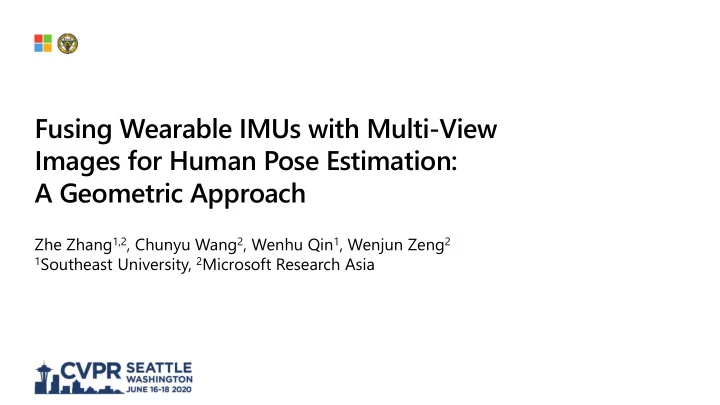

Fusing Wearable IMUs with Multi-View Images for Human Pose Estimation: A Geometric Approach Zhe Zhang 1,2 , Chunyu Wang 2 , Wenhu Qin 1 , Wenjun Zeng 2 1 Southeast University, 2 Microsoft Research Asia
Motivation The Task Recovering absolute 3D human pose in world coordinate system by fusing Wearable IMUs and Multi-View Images Main Challenges It is nontrivial to deeply and effectively incorporate IMUs in the existing image processing pipeline
Contribution We present an approach to fuse IMUs with images for robust pose estimation even when occlusion occurs Cross-Joint-Fusion in both 2D & 3D pose estimation Orientation Regularized Network (ORN) IMU orientations as a structural prior mutually fuse the image features of each pair of joints linked by IMUs Orientation Regularized Pictorial Structure Model (ORPSM) an orientation prior that requires the limb orientations of the 3D pose to be consistent with the IMUs SOTA Results
Orientation Regularized Network (ORN) It firstly takes multi-view images as input and estimates initial heatmaps independently for each camera view. Then with the aid of IMU orientations, it mutually fuses the heatmaps of the linked joints across all views.
Orientation Regularized Network (ORN) The main challenge is to determine the relative positions between each pair of joints (Y P and Y Q ) in the images Since depth is an ambiguity, we find all the possible Y Q corresponding to Y P in a line by adding limb offset ( orientation * length ) We then enhance Y P ’s heatmap by adding maximum response of Y Q line in each view to it
Orientation Regularized Network (ORN) The correct location will be enhanced most, though some irrelevant locations are also enhanced
Orientation Regularized PSM (ORPSM) We introduce a novel limb orientation prior based on IMUs into PSM It works as a soft constraint to let limb comply to IMU orientations Pictorial Structure Model (PSM) Orientation Potential IMU Joint m Joint n
Experimental Results ORN notably improves 2D pose estimation accuracy especially when one joint is occluded.
Experimental Results The grey line shows the 3D MPJPE error of the noFusion approach. • The orange line shows the error difference between our method and noFusion. • If the orange line is below zero, it means our method has smaller errors. • We split the testing samples into two groups according to the error scale of noFusion. •
Experimental Results 3D MPJPE comparison with SOTAs on Total Capture dataset
Qualitative Results
Code aka.ms/imu-human-pose
Recommend
More recommend